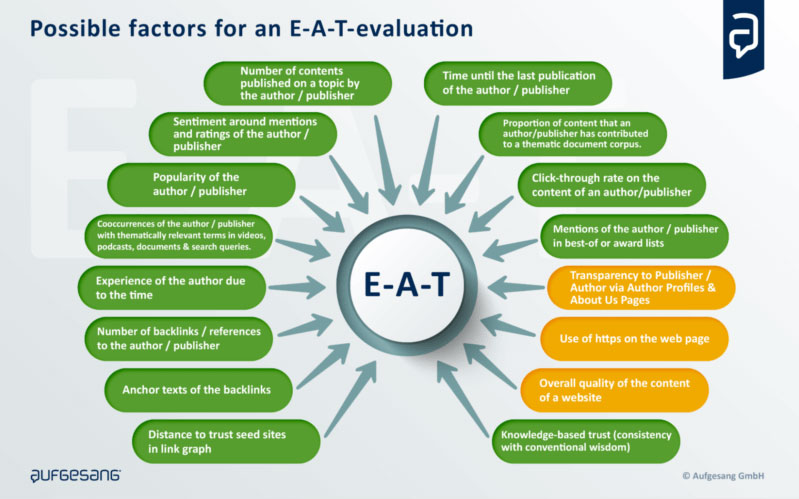This is an archived article and contains information that has not been updated or reviewed since it was originally published. For more information regarding the content in this article, please contact us.
Well what can I say? 2022 has started off in so many unexpected ways that I am quite delayed on writing this year’s round-up of our digital marketing predictions. 2021 certainly didn’t roll out quite as expected, and at this point, we are all learning to just roll with the constant changes. So without further ado, here are my predictions for what is up and coming (and what you need to watch out for) in 2022.
Here are the top digital marketing trends we are watching this year:
- The [slow] death of 3rd party cookies
- Loss of personalized advertising
- Rising ad costs
- The decline of Google Analytics
“Wait! This is all sounding kind of depressing isn’t it?”
- EAT more
- The astronomic rise of short-form video
- SERP refinements
- Meet BERT
- Google My Business Transitions
- Google Ads
- Social Commerce
- The astronomic rise of shortform video
- More legal troubles for Facebook & Google
- The ‘trendy’ stuff
- VR/AR
- NFTs
- Influencer Marketing
- Jenna’s
WildPredictions
1. The [slow] death of 3rd party cookies
Firefox started blocking third-party cookies in 2013. Safari was not long after. And Microsoft has already made “Do Not Track” the default setting in Internet Explorer, while Edge allows you to set your level of “protection”.
Wait, what is a cookie?
A cookie is a small snippet of code that is stored in your web browser when you visit a website.
Third-party cookies are created by domains that are not the website you are actually visiting. They are usually used for advertising.
But what is going on with Google Chrome? In February of last year, Google announced it would phase out the use of 3rd party cookies by 2022. Fast-forward another year and that timeline has been moved to 2023. So yes, 3rd party cookies are going away….slowly.
Many digital advertising platforms are completely reliant on 3rd party data. This slow phase-out gives advertisers more time to build alternative options. The big push now is to ensure your website is tracking first-party data. And then there is the small issue of changing our entire approach to advertising online (see next section).
2. Loss of personalized advertising
Why are we losing personalized advertising? Because personalized advertising requires personal data. Due to a change in consumer sentiment and new legal operating frameworks, it is no longer open season on personal data. In the coming year(s) advertiser access to personal data will be much more limited.
Even before the major players fully address the privacy and data concerns that arise with tracking platform users (the part that allows marketers to personalize ads), there has already been a mass exodus of users who no longer want to arbitrarily give up their personal data to every app they install. We all knew that one person 5 years ago who wouldn’t share their email or sign up for a social media platform. Well, a growing number of people are joining Johnny-naysayer and are opting out of the Google ecosystems and saying “no” to just giving away their personal data.
As technology gives users more control over what data is shared, there is going to be an inevitable decline in the amount of ad personalization we can achieve (your data model is only as good as its inputs of course). Apple iPhone users have had this ability for a year now. Once Google works out how to keep its systems running, while still offering privacy, Android will surely follow suit.
Along the same vein, the major players are going to have to make some significant changes to their data collection practices aligning with increasingly complex regulatory frameworks on personal data governance.
Are we going back to the days when you ran a newspaper ad and hoped the right people will see it? Well, not quite. But certainly in the next year marketers will have to dust off some pre-digital marketing tactics to make sure they are reaching the right audiences. At least until the big guys can find a solution to this conundrum (see my wild predictions below).
3. Rising advertising costs
In 2021 both Facebook and Google saw staggering increases in revenue. These profits were almost entirely driven by increases in ad revenue.
Google increased its revenue by 41% in 2021 or $75.1 BILLION.
Ad costs on Google Ads rose by 23% in 2021, and Facebook costs rose by 33%. Online competition is going nowhere fast. Combined with a reduced ability to target the “right” people or measure your success. You can bet on advertising costs continuing to rise in 2022. Read more on rising ad costs.
4. The decline of Google Analytics
Now here is a controversial topic. Nearly every website we work on is using Google Analytics to measure website engagement and leads. It is the core of how we operate at Ontario SEO and informs nearly every advertising and SEO decision we make.
A couple of recent rulings in the UK have decided that Google Analytics violates the regulations imposed by GDPR legislation. While the digital marketing world has been fairly quiet on this issue, our international clients are certainly watching this closely.
I know international businesses who are impacted by these decisions are actively exploring alternatives to Google Analytics (spoiler alert, there are not many free alternatives). I expect 2022 will bring some significant changes in our core approach to website analysis. But hey, maybe Google will have time between court hearings to solve this one too. Stay tuned on this one folks.
5. EAT more
Ok, enough about the stuff you can’t control! Let’s dive into something you can. In the last few years, there has been a growing focus on understanding the source and validity of information online. Google knows this is important to you, and several search algorithms updates and new SERP features reflect this.
What is EAT? Expertise, Authority & Trust.
While we know that “EAT” is not a direct ranking factor, and we don’t exactly know how Google’s algorithms evaluate expertise, authority, or trust, we do have a good sense of what “good EAT” looks like.
Google has told marketers to pay attention to Google’s Quality Rater Guidelines. And all advertisers would do well to heed Google’s suggestions. Improving your EAT should always start with ensuring you have really high-quality content that answers a user’s query, alongside a website with a strong foundation of technical SEO. But here is a few more things you can consider:
Credibility of Authors
Newer Google patents show that the algorithm will now evaluate author credibility. There are a few ways this may be evaluated including
- A track record in the topic area (published online of course)
- Number of content pieces published by the author
- Length of time from last publication
- User ratings on the published content or similar content by the author
We have some ideas on how to leverage this idea. Want to know more? Reach out!
Co-Occurrences
Your website is quite simply not enough anymore. To have high EAT your website content should be complimented by assets and documents from other sites and platforms. This could include videos, podcasts, or publications for example. Posting your webinar content on YouTube is one really straightforward way of leveraging this information.
Author Profiles & About Us Pages
Do everything you can to tell both website users and Google that there is a real organization behind your website. An easy way to do this is to ensure all of your content authors have individual profile pages and to ensure that your business has a credible looking “About Us” page. Including images, real people, and physical locations further supports this.
Be Smarter with Links
Google algorithms reward anchor text that aligns with the page content. Stop using “read more” or “next” and use your anchor text to provide more context to the page you are linking to.
Build authority in a subject by linking to your own internal content, rather than referencing external blog posts or Wikipedia (and yes, I am not following my own advice in this very section – SEO is both an art and a science).

6. SERP refinements
This time last year I predicted we would see a, “greater refinement in SERP features in 2021”. As we roll into 2022, we are certainly seeing the outcomes of these subtle refinements. In 2020/2021 many of our client websites were ranking for an extraordinary number of featured snippets. We have seen a significant retraction in the available featured snippets in the last 6 months. Time will tell if this will be the norm. The only thing you can expect with the Google SERP is that it will never stay the same.
7. Have you met BERT?
In 2022 Google’s BERT may be becoming your very best friend or your mortal enemy. Have you been following all of our great SEO advice over the years?
BERT stands for Bidirectional Encoder Representations from Transformers. …um yeah. It’s an AI-powered language model used for encoding information.
Google’s BERT uses natural language processing AI to better understand the context around the query you type (or say) in the search window. And every time you search, it keeps getting “smarter”.
How has BERT been changing the SERP since it launched in 2019? Well, that remains to be seen. But for two decades search results pages have transformed the way we humans query machines. As BERT is better able to understand things like word order and prepositions, you will be able to talk to your device the same way you talk to your kids (rather than an alien from another planet). And I expect this will start to change those queries you type in that box.
Feel like deep-diving into Google AI? Check out ai.google.com. Some of their latest language models are now using more than 540 BILLION parameters. Read more about PaLM
There is nothing to “do” to optimize for “BERT”, but you can be sure we have been looking for new ways to leverage more natural language in our technical SEO elements. I shall now foretell the death of the pipe symbol in html page titles. You’re welcome.
8. MUMs the word
Ok, this is the stuff I don’t actually like to share. Google’s MUM update arrived last summer. MUM promises to actually “understand” what a user wants, not just what they searched. It also uses natural language processing, but unlike most previous algorithms, it is not based on only textual content. MUM uses machine learning to also interpret videos, images, and podcasts. Have you noticed more images and videos popping up with your search query?
MUM stands for Multi-Modal Unified Task Model. It’s a newer, better AI-powered Google algorithm.
And this is where things come full circle. Earlier I mentioned creating “co-occurrence” content to create EAT. Well, you are about to get even more for your efforts if you build that content in a way that Google’s newer machine learning algorithms can understand. How do you do that? We’re testing some ideas around here. So stay tuned.
9. Google My Business Transition to Google Business Profile
You have heard of Google My Business, right? (no way you got to this point if you haven’t). Then you have probably heard Google My Business is now Google Business Profile.
Other than the rebrand, there haven’t been too many significant changes with Google My Business this year…GBP I mean. Some features have been added (we’re pretty happy about posts on hotel profiles), while others have been cut back or lost. One big change for direct users is that you can edit most things right in the search results pages now.
I predicted we would see GMB monetized for 2021. While I wasn’t correct, I am still holding onto that prediction for 2022.
10. Google Ads
Last year I predicted the death of the text ad and boy did I nail that one. Sure enough, Google announced in 2021 they would phase out expanded text ads, leaving us with only responsive ad types by July 1st. You have a few months left to use your ETAs for ad copy testing until you have to bow to the whims of the Google Ads algorithm (you know how I really feel).
Changes to Google Ads in 2021 are a post in-themselves. But here is a quick rundown of what changes in 2021:
The end of the expanded text ad
In a push for enhanced conversion tracking and privacy,
Google has rolled out Enhanced Conversion Tracking and “Consent Mode” to try to address some of the issues around 3rd party cookies and ad blockers.
Image extensions
We beta tested this in 2015, so it’s not really new. But it is now available for most accounts.
Performance Max Campaigns
We think even the name implies this is nothing but trouble, but some of our clients are actually seeing decent results with these mysterious “pandora’s box” campaigns. As with most things on Google Ads, test, test, and test again to see if this will work for you.
More automated bidding strategy options
Again test before your buy (in). There are some promising results coming from newer biddings strategies. We are finding that data inputs are critical to making automated bidding work. We also know that these things tend to work much better for industries Google “knows”. If you are a niche industry, tread cautiously into automated bidding. But as always, you won’t know until you test.
11. Social Commerce
Ecommerce is not showing any signs of slowing down. In 2021 we saw virtually all online platforms expand their ability to sell products online through their social media platforms (does YouTube count as social media yet?). Google had several algorithm updates focused solely on products and product reviews. While Facebook Meta has been making large investments in in-app purchase capabilities.
While social commerce only represented 10% of transactions in 2021, that figure is expected to grow to 17% by 2025 (source). Businesses that have been neglecting their organic social channels, and/or who have not been advertising there, should pay closer attention to this trend.
12. LinkedIn for B2B
LinkedIn and Microsoft Ads in general have been quietly (?) building a solid following of engaged professional audiences. There are now 740 million members and 55 million registered companies on LinkedIn. And (this is staggering to me) nearly 40% of users access LinkedIn DAILY.
Unlike “the METAverse”, LinkedIn is much more popular with men and highly skewed to millennials (who make up 60% of the userbase).
We are very interested in leveraging some of the newer targeting options and opportunities LinkedIn offers. The cost for LI advertising is still prohibitive to most SMBs, but we are testing ways to make LinkedIn drive a positive ROI for some larger clients. We hope to translate these learnings to smaller campaigns in the future.
13. The astronomic rise of shortform video
Yes. I have heard of TikTok (ok, if I am being honest, I watch them too). No, we have not run any TikTok ads yet. There is no denying that short-form video has experienced an astronomical rise in 2021 (maybe we all just had too much free time?). As this medium matures, I am certain there will be great opportunities for advertisers to leverage TikTok and Insta reels, but I am skeptical there is any measurable ROI there yet. For now, we will leave TikTok to the influencers and stick to the advertising return we can measure.
14. More legal troubles for Facebook & Google
On a slow news day (distressingly infrequent lately), you will likely hear of the latest ruling, filing, or court injunction filed against one of the big tech giants. Most developed jurisdictions in the world have rolled out, or are introducing, more strict personal data protection laws. European courts have declared Google Analytics to be in violation of GDPR. French and Australian news publications are demanding their fair share of Google’s profits. Governments across the globe are finally cracking down on the giant global monopolies that run the internet with antitrust lawsuits.
You can bet there are high-paying jobs in the legal department at Google and Facebook Meta these days. Luckily for advertisers, these legal battles will likely play out over years, so there is little to action in the short term.
15. The ‘trendy’ stuff
VR/AR
Welcome to the metaverse? (but really, not quite yet). Well, I think it is always a good idea to stay apprised of these trends, I don’t think the metaverse is a realistic place to focus any marketing efforts just yet. I suppose there can be some value in “being first”, but honestly this is not going to make sense for the vast majority of businesses.
Google and Facebook Meta are investing significantly in these areas, so we can be certain the metaverse will be important some day in the future. That day is not today.
NFTs
Are you under 25? Then jump on the bandwagon and make some $$$.
In all seriousness, NFTs may be more important for “brand business” in the coming years. But just like the metaverse, making significant investments here for most businesses just doesn’t make sense yet. On a personal side, if you want to make a quick buck, try pumping and selling some NFTs – it’s not illegal (yet).
Influencer Marketing
As I said last year, influencer marketing is not going anywhere. It can be a very compelling way to convert your target audiences. But influencer marketing is wrought with challenges, and it only really works if you get the formula “right”.
Right now, making a dent with influencer marketing is expensive and it’s difficult to measure results. This is certainly not our realm (though we love to develop strategies to complement your influencer campaigns). We highly recommend working with someone with expertise in influencer marketing before venturing into this sphere. As this industry grows, we expect to see more out-of-box solutions from influencer marketing agencies for SMBs. But for now, this is an expensive and time-consuming digital channel for your advertising dollars.
16. Jenna’s Wild Predictions
Machine Learning & Modelling will solve personalization issues
In 2021 Google experimented with FLoC (Federated Learning of Cohorts) . They recently killed this project (or re-branded it??) and are now pursuing “Topics”. The basic idea is that Google will use your browsing history to identify your interests. Then randomly select interests to share with an advertising platform. I am no engineer, so time will tell how this will pan out.
However, what Google is experimenting with here signals their intention to use data aggregated across vast sources of information to model ad personalization. Is it perfect? Nope. But scientists, actuaries, and economists have been using predictive models for decades. With the right dash of sophisticated engineering, I have no doubt Meta and Google can overcome this data personalization issue. No one thought this personal data bonanza was going to last forever, did they?
Google Ads will remove manual bidding options
I know I predicted this last year, but I really think the days of manually manipulating things in Google Ads is over. We may retain some small levers to pull, but I am finally ready to admit that the machines have won here. If you can’t beat ‘em, join ‘em.
Wait, no! Don’t just join them. Make sure you have a PPC management team who knows the in’s and out’s of all Google’s automated options so you can invest your PPC dollars for maximum returns.
The Tech Giants will get more giant
Despite the HUGE legal and ethical challenges facing tech companies in 2022, they aren’t going anywhere. I expect we will continue to see gigantic profits and more user adoption worldwide. Between 5G networks, recovering economies, and pent-up pandemic demand, you know the tech giants are going to rake in huge profits in 2022 (even if they also rack up giant legal fees and fines).
2022 is going to be a tumultuous year in digital advertising. Our approach of testing, relentless optimization, and continuous professional development gives our team the unique ability to anticipate changes and insulate our clients from challenges. Want to know more about how you can leverage the collective knowledge of our team for your digital marketing efforts?
But seriously, we are really really good at this. Get in touch!



